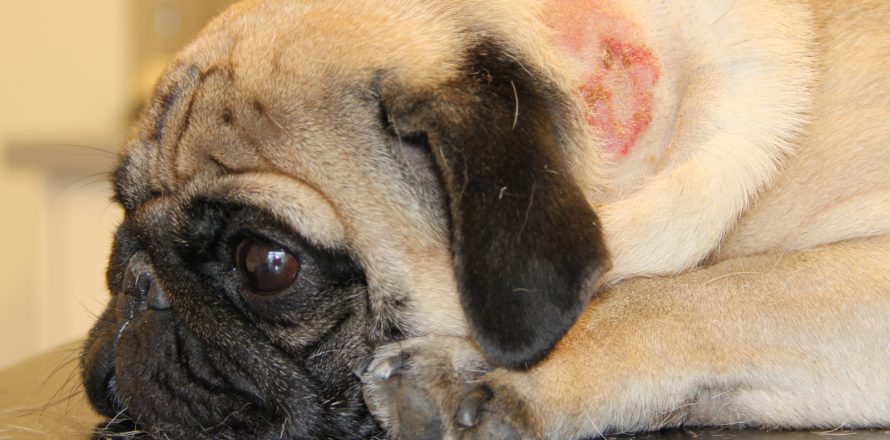
When Bruce started itching at the back of his neck, Martina first thought that he had been bitten by another dog. He plays enthusiastically with other dogs, and maybe he had been grabbed by the back of the neck by one of his “friends”. When the sore area grew bigger, turning bright red, and oozing secretions. Martina brought him to see me to find out what was going on.
I had to clip the fur away from the area to see what was happening to Bruce’s skin. Once I’d done this, I could see that there were two red areas, each the size of a two euro coin. As I examined the area, Martina spoke up. “I know what has caused this”, she said. “It’s his food allergy again”.
This isn’t the first time that Bruce has suffered from sore patches of skin. Since he was a young adult, he has suffered from regular episodes. When the problem started, we carried out a detailed investigation of the cause, including a skin biopsy. As part of the work up, Bruce was put onto a trial diet of just fish and rice, and the effect was almost like magic. The sore patches of skin cleared up, and there was no recurrence. When he was accidentally allowed to eat some normal dog food, the skin problem flared up again. The diagnosis was clear: Bruce suffers from a food allergy.
Food allergy
Food allergies are well recognised in humans: everyone has heard of people who can suffer dramatic, life-threatening reactions when exposed to foods like peanuts. Dogs don’t suffer from such an extreme version of food allergy – they don’t collapse or have a severe episode of breathing distress. Instead, food allergies tend to cause gastro-intestinal signs (such as diarrhoea) or signs such as those shown by Bruce – itchy skin.
Food allergy cannot be diagnosed by blood tests or skin tests: the only way that the problem can be identified is by ruling out all other causes of itchy skin, then carrying out a dietary trial. This means putting the dog onto foods that he has not experienced before, so that there is no way that his body can have had time to develop an allergy to them. Bruce was originally given a trial using a special veterinary diet made from fish (as a protein source) and tapioca (as a carbohydrate source). He improved immediately, and from then on, Martina learned that he had to avoid a whole range of different foodstuffs. Bruce’s skin stays healthy as long as he stays on his special diet, but if he eats anything else, his skin flares up with red, sore patches.
The problem is that Bruce has a healthy appetite, and if he gets a chance, he happily eats anything that’s offered to him. Martina can normally control his food intake effectively, but there are three danger areas. First, he hovers around Martina’s fifteen month old daughter when she is eating. She drops food to the floor, and Bruce is there to grab it. Second, Martina leaves food out in the garden for the birds, and Bruce is quick to dart out and eat it if he gets a chance. And third, other people don’t always know about his problem, so when there are house visitors, he may be given scraps of the wrong food, or if he visits friends or family, they tend to be more relaxed about feeding him.
Bruce needed some soothing ointment for the sore patches of skin, but Martina already knew what was needed for her dog: back to that boring fish and rice diet.
Tips
- Food allergies are common in dogs, causing itchy skin
- The diagnosis is made by carrying out a dietary trial
- To cure the problem, a strict diet is needed for the whole of the dog’s life




Please note that I am unable to answer veterinary questions in comments. If you have questions or concerns about your pet's health it is always better to contact your vet.